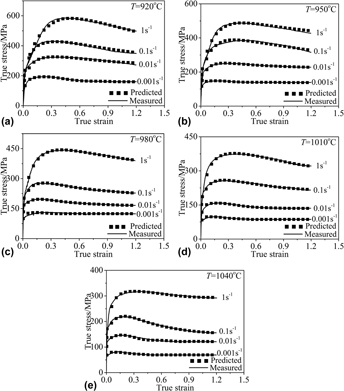Crossref Citations
This article has been cited by the following publications. This list is generated based on data provided by
Crossref.
Lin, Y. C.
Wen, Dong-Xu
Chen, Ming-Song
and
Chen, Xiao-Min
2016.
A novel unified dislocation density-based model for hot deformation behavior of a nickel-based superalloy under dynamic recrystallization conditions.
Applied Physics A,
Vol. 122,
Issue. 9,
Quan, G.-Z.
Wang, X.
Li, Y.-L.
and
Zhang, L.
2017.
Analytical Descriptions of Dynamic Softening Mechanisms for Ti-13Nb-13Zr Biomedical Alloy in Single Phase and Two Phase Regions.
Archives of Metallurgy and Materials,
Vol. 62,
Issue. 4,
p.
2029.
Wen, Dong-Xu
Lin, Y.C.
and
Zhou, Ying
2017.
A new dynamic recrystallization kinetics model for a Nb containing Ni-Fe-Cr-base superalloy considering influences of initial δ phase.
Vacuum,
Vol. 141,
Issue. ,
p.
316.
Chen, Fei
Ou, Hengan
Gatea, Shakir
and
Long, Hui
2017.
Hot tensile fracture characteristics and constitutive modelling of polyether-ether-ketone (PEEK).
Polymer Testing,
Vol. 63,
Issue. ,
p.
168.
Bobbili, Ravindranadh
Venkata Ramudu, B.
and
Madhu, Vemuri
2017.
A physically-based constitutive model for hot deformation of Ti-10-2-3 alloy.
Journal of Alloys and Compounds,
Vol. 696,
Issue. ,
p.
295.
Liu, Yan-Xing
Lin, Y.C.
and
Zhou, Ying
2017.
2D cellular automaton simulation of hot deformation behavior in a Ni-based superalloy under varying thermal-mechanical conditions.
Materials Science and Engineering: A,
Vol. 691,
Issue. ,
p.
88.
Liu, Yan-Xing
and
Lin, Y.C
2018.
A Yield Stress Model for a Solution-Treated Ni-Based Superalloy during Plastic Deformation.
High Temperature Materials and Processes,
Vol. 37,
Issue. 9-10,
p.
849.
Lin, Y.C.
Luo, Shun-Cun
Yin, Liang-Xing
and
Huang, Jian
2018.
Microstructural evolution and high temperature flow behaviors of a homogenized Sr-modified Al-Si-Mg alloy.
Journal of Alloys and Compounds,
Vol. 739,
Issue. ,
p.
590.
Lin, Y.C.
Dong, Wen-Yong
Zhou, Mi
Wen, Dong-Xu
and
Chen, Dong-Dong
2018.
A unified constitutive model based on dislocation density for an Al-Zn-Mg-Cu alloy at time-variant hot deformation conditions.
Materials Science and Engineering: A,
Vol. 718,
Issue. ,
p.
165.
Chen, Rongchuang
Guo, Peng
Zheng, Zhizhen
Li, Jianjun
and
Feng, Fei
2018.
Dislocation Based Flow Stress Model of 300M Steel in Isothermal Compression Process.
Materials,
Vol. 11,
Issue. 6,
p.
972.
Chen, Gang
and
Zhao, Xiaochen
2018.
Constitutive modelling on the whole-life uniaxial ratcheting behavior of sintered nano-scale silver paste at room and high temperatures.
Microelectronics Reliability,
Vol. 80,
Issue. ,
p.
47.
GUO, Lianggang
WANG, Fengqi
ZHEN, Pengliang
LI, Xuechao
and
ZHAN, Mei
2019.
A novel unified model predicting flow stress and grain size evolutions during hot working of non-uniform as-cast 42CrMo billets.
Chinese Journal of Aeronautics,
Vol. 32,
Issue. 2,
p.
531.
Chen, Fei
Wang, He
Zhu, Huajia
Zhu, Hongyang
Ren, Facai
and
Cui, Zhenshan
2019.
High-temperature deformation mechanisms and physical-based constitutive modeling of ultra-supercritical rotor steel.
Journal of Manufacturing Processes,
Vol. 38,
Issue. ,
p.
223.
Cao, Sainan
Gu, Hai
Yang, Jianchun
Li, Bin
Jiang, Jie
Zhang, Jie
and
Xu, Ningping
2019.
Laser rapid forming processing of TiC reinforced nickel-based superalloy composites: Influence of additive TiC particle content.
Journal of Laser Applications,
Vol. 31,
Issue. 3,
Chen, Fei
Gu, Hailun
Zhu, Huajia
Ma, Wujiang
and
He, Jianli
2019.
A Comparative Study on Constitutive Modeling for Flow Behavior of Ultra-Supercritical Steel at High Temperature.
Journal of Materials Engineering and Performance,
Vol. 28,
Issue. 12,
p.
7475.
Meng, B.
Cao, B.N.
Wan, M.
Wang, C.J.
and
Shan, D.B.
2019.
Constitutive behavior and microstructural evolution in ultrasonic vibration assisted deformation of ultrathin superalloy sheet.
International Journal of Mechanical Sciences,
Vol. 157-158,
Issue. ,
p.
609.
Wang, Jinhui
Yuan, Xiaoguang
Jin, Peipeng
Ma, Hongbin
Shi, Bo
Zheng, Hongshan
Chen, Tengyu
and
Xia, Wenchao
2020.
Study on modified Johnson-Cook constitutive material model to predict the dynamic behavior Mg-1Al-4Y alloy.
Materials Research Express,
Vol. 7,
Issue. 2,
p.
026522.
Zhang, Jing-Yu
Jiang, Ping
Zhu, Ze-lin
Chen, Qiang
Zhou, Jie
and
Meng, Yi
2020.
Tensile properties and strain hardening mechanism of Cr-Mn-Si-Ni alloyed ultra-strength steel at different temperatures and strain rates.
Journal of Alloys and Compounds,
Vol. 842,
Issue. ,
p.
155856.
Sohrabi, Mohammad Javad
Mirzadeh, Hamed
and
Dehghanian, Changiz
2020.
Significance of Martensite Reversion and Austenite Stability to the Mechanical Properties and Transformation-Induced Plasticity Effect of Austenitic Stainless Steels.
Journal of Materials Engineering and Performance,
Vol. 29,
Issue. 5,
p.
3233.
Kotkunde, Nitin
Badrish, Anand
Morchhale, Ayush
Takalkar, Prathamesh
and
Singh, Swadesh Kumar
2020.
Warm deep drawing behavior of Inconel 625 alloy using constitutive modelling and anisotropic yield criteria.
International Journal of Material Forming,
Vol. 13,
Issue. 3,
p.
355.



